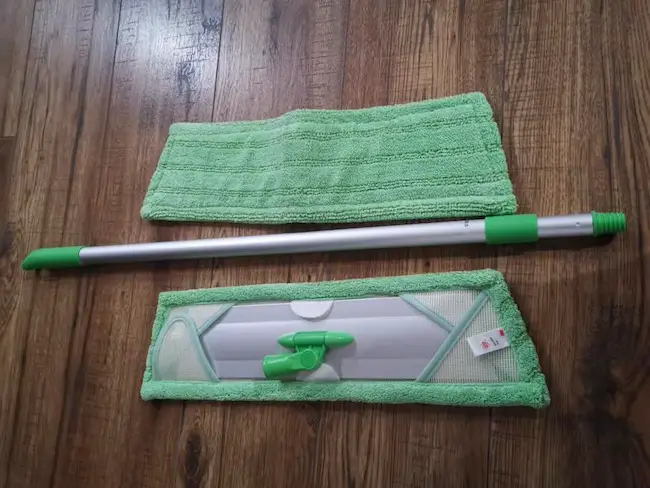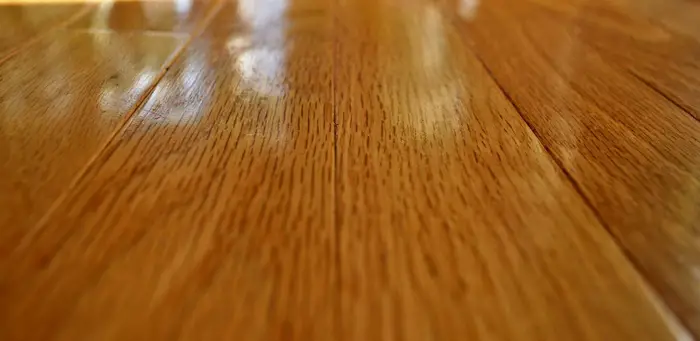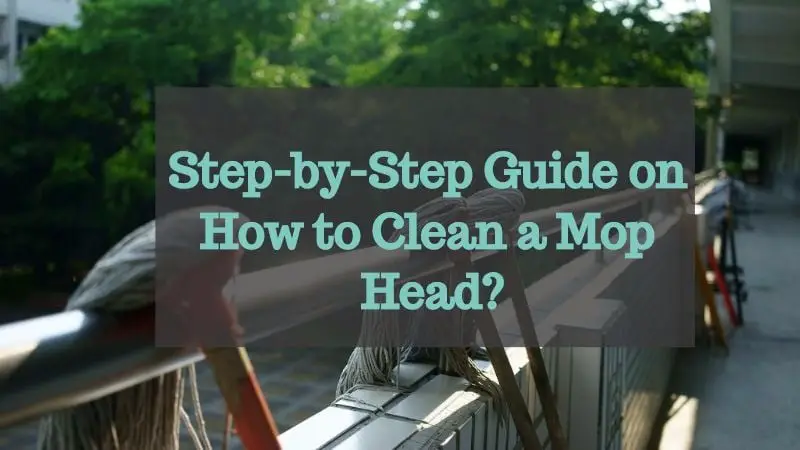There’s no denying that the microfiber mop pads are one of the most important cleaning tools that every household needs to stay tidy. They are not only brilliant at cleaning different types of surfaces but also have several other benefits. Plus, you can reuse them after cleaning, as long as you like. One of the biggest advantages of using microfiber mop pads for cleaning houses is that they can be washed easily.
How to clean microfiber mop pads? These detachable pads can be easily cleaned in a washing machine or hand washed with a mild detergent. You can also dry the microfiber mop pads quickly in a dryer but make sure you keep them away from heat. You should also not use any type of fabric softeners or bleach while cleaning.
In this post, I have laid down a few guidelines to help you with cleaning the microfiber mop pads. However, before we go further, let’s take a look at what these pads are made of and how they work. Unlike the traditional style of mops, the microfiber mop (see my reviews) is made of synthetic materials. From the time the microfiber became available, the manufacturers of cleaning products started using it to make a wide range of cleaning tools.
When compared to cotton, the microfiber material is much lighter and holds nearly 7 times its total weight in water. It also more efficient at picking up the dust, dirt, and debris while cleaning. The electrostatic properties of the microfiber ensure that you get a good cleaning without having the dust spread around the area. This is precisely why the microfiber mop pads are so sought after by the professionals.
Cleaning Microfiber Pads In The Washing Machine
The easiest method of cleaning your microfiber thoroughly is to put it in the washing machine. As this is an effortless process, you will not have any problems cleaning the microfiber mop pads after the task is completed to ensure that the pads stay clean and last longer.
Before washing the microfiber pads
The microfiber material has a good gripping quality hence pet dander and human hair stick to it like a magnet. Splinters and wooden chips can also get entangled into the microfiber loops. Make sure you shake the mop pad vigorously to remove any large particles and heavy debris before washing. You may also use an old brush or comb to dislodge the dust and debris. Now, it’s ready to put into the washing machine.
Use of detergent
The most important thing is perhaps the type of detergent you use to clean the microfiber mop pad, and you should pay due attention to it. While most of the manufacturers would provide detailed instructions, there are some general rules that apply. Remember to always use a mild detergent, either powder or liquid-based with hot or warm water for best results. Both are fine as long as they are not soap-based or self-softening. Also, make sure that they are not oily. Try to use mild detergents that are natural and unscented.
You should avoid using fabric softeners as they can clog the open spaces in the pad that are responsible for cleaning, thus make the product useless. The microfiber may catch lint in the wash cycle in a similar way as it grabs dust, dirt, and debris. Hence, be careful with what you put into the washer along with the microfiber mop pad. Avoid washing it with socks, towels, and terry cloths, etc. I would suggest that you wash the microfiber pad only with microfiber material. If you must mix the loads, make sure you only use non-linting cloth materials.
Pro tip: Make sure you do not use a non-chloride detergent. Also, you don’t need a lot of detergents, just a little to pull out the dirt and microscopic germs. Bear in mind that you won’t be wearing the cloth, so washing can be done a bit differently. Releasing the dirt and grime may be enough to keep your microscopic pad clean and last longer.
Washer Settings
Check the microfiber pad to see how clogged it is. If there are any large residues, break it up with a brush to enable the washer to clean them up thoroughly. When that is done, add the pads to the washing machine and use warm or hot water for the wash cycle. Hot water will help in easily dislodging any sticky stuff like wax, chemicals and nasty germs between the fibers.
The standard length of the wash cycle should be 20-30 minutes to get the job done effectively. I would suggest that you use a medium speed setting (marked as normal or regular on your washer) to ensure that the pads are cleaned properly. Allow the washer to do its job and properly sanitize your microfiber mop pads without much wear and tear.
Drying Microfiber Mop Pads
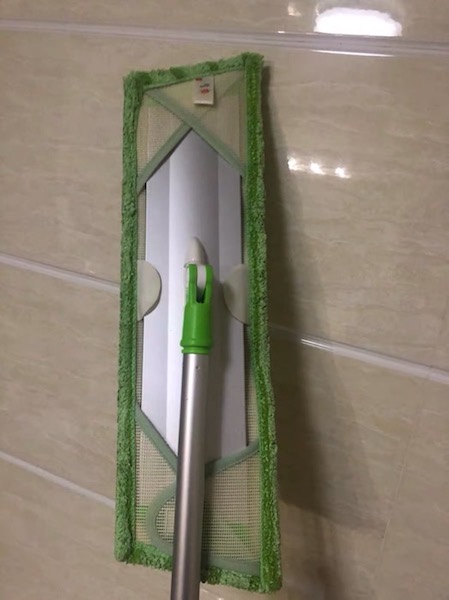
After the washing cycle is complete, take the pads out of the washer and decide how you wish to dry them. I would say that air drying is the best option and most people would go with it. Fortunately, the microfiber fabric is such that it dries pretty quickly so it won’t take very long. You just need to hang them in an airy place and let them dry completely before putting away. The reason why air-drying is so preferred is that drying in machines could damage the cloth if not done properly. So, save yourself the trouble and just air dry with ease.
If you must dry your microfiber pads in the machine, make sure you choose the settings very carefully. Never use high temperature, instead opt for the low heat or no heat setting. High temperatures can damage the quality of pads, so remember to double-check.
Cleaning Instructions for Commercial Microfiber
You must have seen those heavy and large microfiber pads like this that are used to clean floors in the malls, supermarkets, hospitals, and so on. They pick up a lot more dirt than a house pad because public areas see a lot of footfall than a home. As a result, you need a larger and more powerful microfiber pad to clean these areas. You should also clean these commercial pads carefully to guarantee maximum performance and longevity.
When it comes to detergent, choose a high solvent one for heavy soil. It should not contain Alkaline. The dose is typically decided as per the product specifications. Avoid using bleach or fabric softener.
Flush the microfiber pads for two minutes at 140º F and then run in the wash cycle for 25 minutes at 160º F. Rinse for 2 minutes at an 80º F and then extract for about 5-6 minutes.
For drying of the commercial pads, three different options are mostly used. The first option includes tumble dry at a maximum temperature of 140 degrees. However, remember that air dry is a preferred option that can extend the life of the pads.
The second option includes injecting the disinfectant in the final rinse and not drying. The disinfectant residual will curb the growth of mildew before use.
The third option is that you do not dry the mops at all. Instead, put them in the bucket and add chemical-based products. The mop will be saturated in just 30 minutes and ready to use.
Storing The Cleaned Microfiber Mop Pads
While this may seem pretty obvious to the readers, let me put it down here anyway. Remember to keep all your microfiber materials in a clean and dry area. As mentioned before, the microfiber fabric can easily catch even the tiniest particles of dust. You need to make sure that you don’t clog the spaces before you start cleaning, so store them in a dust-free cabinet.
Tips To Clean Better With Microfiber Mop Pads
Whether you use them at home or commercial areas, the microfiber mop pads are capable of capturing a lot of dust and dirt when used properly. The ultra-fine design and fabric make sure you clean really well. With the effective cleaning tool, you can get good results with less effort. Here are a few tips to help you clean better with the microfiber pads:
#1. Dry clean before using the wet mop head
Use the microfiber mops to collect dry dust before doing the wet cleaning. The fine fibers of the microfiber pad will capture the dust particles easily and quickly. It is easier to remove the dust when it is dry because using a wet mop on dust particles will only create a mess. This holds true for the crumbs, hair particles, and dirt. A quick sweep of the dry microfiber mops can give you a clean surface in minutes.
#2. Follow instructions while washing
The microfiber mop pads can withstand frequent washing than any other standard cleaning-materials made of cotton or other materials. So, it’s absolutely fine if you wash the microfiber pads regularly after every use to keep them clean and hygienic. Just follow the washing dos and don’ts mentioned above while cleaning as well as drying the microfiber mop head.
#3. Less water is more
When cleaning microfiber, remember that this fabric is capable of absorbing more water than any other alternative materials, so you can get effective cleaning with minimum wastage. Avoid using too much water when hand washing the microfiber mops. Don’t leave the mop in the bucket for too long. Dip in and out quickly to allow it to absorb only as much water needed for cleaning. If required, you may add more water later.
#4. Alternate pads to maximize their lifespan
Whether you use microfiber mops for cleaning houses or commercial spaces, try to alternate between two or more pads to ensure that each lasts longer. If you do cleaning every day with microfiber mop pads, consider buying in bulk amount to eliminate the risk of running out of a spare piece when needed.
Signs That Indicate You Need To Replace Your Microfiber Mop Pads
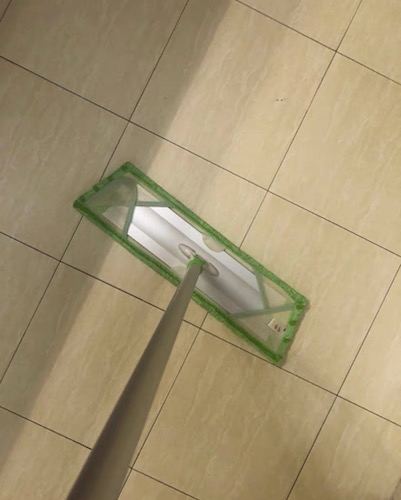
The microfiber pads have brought about a revolution in the cleaning industry with more people using them to get clean surfaces at home, office, or commercial areas. These mops have the ability to transform any type of cleaning job and boost both the speed and efficiency at which cleaning is performed. However, they also undergo wear and tear with time. Here are some signs that indicate your microfiber mop pad need a replacement:
#1. The adhesive quality of microfiber mop pads make it possible for the material to capture thousands of dirt, dust, and tiny lint particles. As a result, it cleans brilliantly with just water and without the need for any chemical-based cleaning products. However, if you notice that the pads are unable to grab as much dirt as they used to do before, this means you need to replace it.
#2. The time to change the microfiber mop pad may also depend upon the types of the surface where it is used. For example, the ones that are used in hospitals are exposed to blood, chemicals, and other hazards. Thus, they need to be washed more frequently. The pads used in a small office may not require so much cleaning. A good quality microfiber mop head can withstand between 500-1000 washes, and beyond that, they tend to lose their effectiveness.
#3. The microfiber mop pad is capable of absorbing a lot of water but with time, the absorbing capacity may get depleted. If you see that the pads are unable to hold as much water as they used to before, this also calls for a replacement.
#4. When the microfiber mop pad has been used for several years, you may seem some signs of wear such as fraying on the edges. The stitching may not be able to hold up well and the label may be curled. If the pores look clogged and no amount of washing helps in clearing them up then that indicates your mop needs a new head.
Benefits of Using Microfiber Mop Pads
Whether your house gets very dirty, you have a huge pet that goes about creating a mess, or there are naughty little kids that break havoc with food droppings and liquid spills everywhere, the microfiber mop pads can take care of all that. Here are a few reasons why house owners, as well as commercial cleaners, prefer microfiber mop pads over traditional pads.
Boosts cleaning power: The microfiber pad helps in cleaning more effectively by getting to the hard to reach places with ease. With it, you can reach the various surface crevices and pores while the cotton pad is too large to allow deep cleaning.
No use of chemicals in cleaning: The microfiber mops are capable of using 10-20 times less water than the traditional cotton mop pads, thus they help in keeping the costs low. You can clean houses, offices, and commercial spaces with just water and no chemicals.
Aids in increasing productivity: If dipping and wringing gave you backaches and muscle sprains while cleaning, you can now say goodbye to them. With the microfiber mop pads, you can clean a large area without needing to dip the mop head again in water.
Reduces cross-contamination: This is another amazing advantage that makes microfiber mop pads suitable for healthcare facilities. To reduce cross-contamination risks, some state laws make it mandatory for healthcare facilities to change the mop or cleaning solution after each patient’s room. With an easy to use microfiber flat mops, it is easier to adhere to this law.
Lesser risk of injury: The microfiber mops are lightweight, significantly less than the traditional cotton loop mops, hence they are much more ergonomic and simple to use. If you perform wet cleaning with a microfiber pad, the floor not only get cleaned brilliantly but there’s not much moisture left behind, hence this reduces the risk of falling or slipping accidentally.
Related Article: 10 Tips For Mopping The Floor To Make It Clean Enough To Eat On
Related Questions
How long can the microfiber mop pads last?
The microfiber pads can last for 40-60 wash cycles, provided you take good care of the product while using and washing.
What can you clean with microfiber mops?
The microfiber mops are extremely versatile hence you can use them to clean a variety of surfaces. They can be used to clean floors, ceiling, porches, cars, windows, and so on. The replaceable pads make it easier to switch when needed, so you can transform the dry mop to a wet mop within seconds.
What types of surfaces can be cleaned using the microfiber mops?
The microfiber mops can be safely used to clean different types of surfaces from hardwood and tile to laminate floors. The mops can be used on metal and concrete floors without any issues. The microfiber steam mops may also be used to clean carpets and rugs with ease.
Do I need to use a chemical or cleaning solution with microfiber mops?
For more of the surfaces, you can get a clean surface by just using plain water. However, if there’s a spill or sticky substance you may use vinegar or dish soap liquid to get rid of the stubborn stains and dirt.
Are the microfiber mops good for dry or wet cleaning?
The biggest advantage of using microfiber mops is that they are good for both dry and wet mopping. They can render the straw broom obsolete and do a great job at wet mopping the house clean. They are great at picking dirt and dust and use less water to give a squeaky clean surface.
